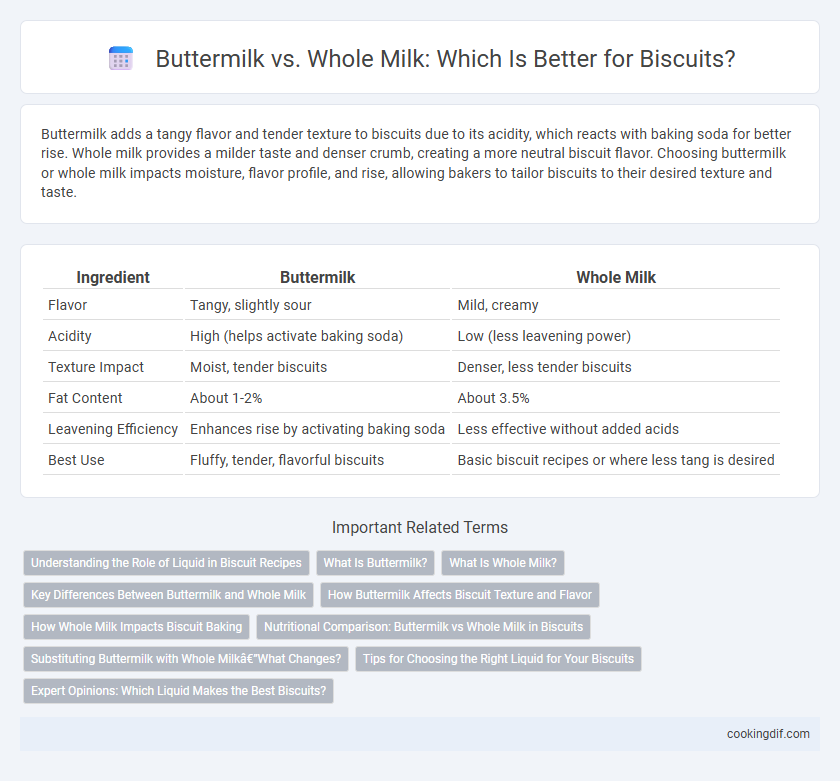Buttermilk adds a tangy flavor and tender texture to biscuits due to its acidity, which reacts with baking soda for better rise. Whole milk provides a milder taste and denser crumb, creating a more neutral biscuit flavor. Choosing buttermilk or whole milk impacts moisture, flavor profile, and rise, allowing bakers to tailor biscuits to their desired texture and taste.
Table of Comparison
| Ingredient | Buttermilk | Whole Milk |
|---|---|---|
| Flavor | Tangy, slightly sour | Mild, creamy |
| Acidity | High (helps activate baking soda) | Low (less leavening power) |
| Texture Impact | Moist, tender biscuits | Denser, less tender biscuits |
| Fat Content | About 1-2% | About 3.5% |
| Leavening Efficiency | Enhances rise by activating baking soda | Less effective without added acids |
| Best Use | Fluffy, tender, flavorful biscuits | Basic biscuit recipes or where less tang is desired |
Understanding the Role of Liquid in Biscuit Recipes
Buttermilk creates tender, flaky biscuits by reacting with baking soda to produce carbon dioxide, resulting in a lighter texture and slight tangy flavor. Whole milk contributes to a richer, denser biscuit with a neutral taste, as it lacks the acidity needed for leavening reactions. Understanding the acidity and fat content differences between buttermilk and whole milk helps optimize biscuit moisture, rise, and flavor profile.
What Is Buttermilk?
Buttermilk is a fermented dairy product made by adding lactic acid bacteria to low-fat milk, resulting in a tangy flavor and thicker texture compared to whole milk. It contains higher acidity, which reacts with baking soda to produce carbon dioxide, helping biscuits rise and become fluffy. Unlike whole milk, buttermilk enhances the tenderness and adds a subtle tang that balances the biscuit's richness.
What Is Whole Milk?
Whole milk contains about 3.25% fat, providing a rich and creamy texture ideal for biscuit doughs. Its higher fat content compared to buttermilk contributes to tender, flaky biscuits with a moist crumb. Using whole milk in biscuits yields a mild flavor and soft crumb, while buttermilk introduces acidity for a tangy taste and enhanced rise.
Key Differences Between Buttermilk and Whole Milk
Buttermilk contains higher acidity due to lactic acid, which reacts with baking soda to create a lighter, fluffier biscuit texture, whereas whole milk has a neutral pH and results in denser biscuits. Buttermilk tends to add a slightly tangy flavor and richer moisture content, enhancing tenderness, while whole milk delivers a creamier taste without altering the biscuit's rise. The fat content in whole milk is about 3.25%, supporting a mild richness, but buttermilk's fermentation contributes unique thickening properties absent in whole milk.
How Buttermilk Affects Biscuit Texture and Flavor
Buttermilk's acidity reacts with baking soda to create a lighter, fluffier biscuit texture through increased carbon dioxide release, enhancing rise and tenderness. It imparts a subtle tangy flavor that enriches the overall taste, contrasting with the milder, creamier notes produced by whole milk. The lactic acid in buttermilk also helps break down gluten, resulting in a softer crumb and more delicate bite compared to whole milk.
How Whole Milk Impacts Biscuit Baking
Whole milk enhances biscuit baking by providing higher fat content compared to buttermilk, which results in a richer, more tender crumb and a golden brown crust. The natural sugars in whole milk promote Maillard browning, improving both flavor and appearance. Moisture from whole milk contributes to a soft, flaky texture, making biscuits light yet satisfying.
Nutritional Comparison: Buttermilk vs Whole Milk in Biscuits
Buttermilk contains fewer calories and less fat than whole milk, making it a lighter option for biscuit recipes while providing a tangy flavor and tender crumb due to its acidity. Whole milk offers higher levels of calcium, vitamin D, and fat, contributing to a richer texture and more moisture in biscuits. Choosing between buttermilk and whole milk affects the nutritional profile and texture, with buttermilk enhancing protein content and aiding leavening for fluffier biscuits.
Substituting Buttermilk with Whole Milk—What Changes?
Substituting buttermilk with whole milk in biscuit recipes alters acidity and texture, as buttermilk's lactic acid reacts with baking soda to create a lighter, fluffier crumb. Using whole milk can result in denser biscuits with a less tender crumb unless an acid like vinegar or lemon juice is added as a buttermilk substitute. The moisture content remains similar, but the subtle tang and softness unique to buttermilk biscuits may diminish when replaced by whole milk.
Tips for Choosing the Right Liquid for Your Biscuits
Buttermilk enhances biscuit tenderness and adds a subtle tang, while whole milk provides a milder flavor and softer texture. For flakier biscuits, choose buttermilk due to its acidity that reacts with baking soda, creating lift and lightness. Use whole milk when a neutral taste and slightly denser crumb are preferred, ideal for versatile biscuit recipes.
Expert Opinions: Which Liquid Makes the Best Biscuits?
Experts often favor buttermilk over whole milk for biscuits due to its acidity, which reacts with baking soda to create a lighter, fluffier texture. The tangy flavor of buttermilk enhances the biscuit's taste, providing a subtle depth that whole milk lacks. Whole milk can produce tender biscuits but typically results in a denser crumb compared to the airy rise achieved with buttermilk.
Buttermilk vs Whole milk for liquid ingredient Infographic

 cookingdif.com
cookingdif.com